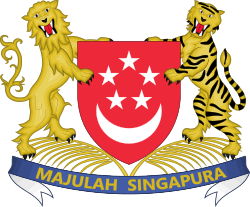Transport in Singapore
Transport within Singapore is mainly land-based. Many parts of Singapore, including islands such as Sentosa and Jurong Island are accessible by road. The other major form of transportation within Singapore is rail: the Mass Rapid Transit which runs the length and width of Singapore, and the Light Rail Transit which runs within a few neighbourhoods. The main island of Singapore is connected to the other islands by ferryboat services.
| Part of a series on the |
| Economy of Singapore |
|---|
 |
| Economic history of Singapore |
| Sectors |
|
|
|
There are two bridges which link Singapore to Malaysia – the Causeway, and the Second Link. The Singapore Changi Airport is a major aviation hub in Asia, and Singapore is a major transshipment port.
McKinsey’s Urban Transportation report rank Singapore's transport system world's best overall based on five criteria - availability, affordability, efficiency, convenience, sustainability.[1] Singapore also has one of the most cost-efficient public transport networks in the world, according to a study by London consulting firm Credo.[2] With the emergence of driverless vehicles, Singapore is now among the favourite locations for autonomous vehicles development testing location for the big players in the automotive industry. [3]
Rail transport
Mass Rapid Transit (MRT)
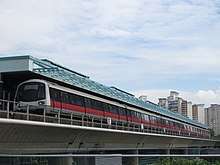
The Mass Rapid Transit, which opened in 1987, is a heavy rail metro system that serves as the major backbone of Singapore's public transport system along with public buses; as of January 2020, the network has a length of 203 km (126.14 mi) and 122 stations. The Land Transport Authority, the main planning authority of the MRT, plans to provide a more comprehensive rail transport system by expanding the rail system to a total of 360 km (223.69 mi) by the year 2030, with eight in ten households living within a 10-minute walking distance of an MRT station.[4]
The current MRT network consists of six main lines: the North South Line, East West Line, Circle Line and partially-opened Thomson–East Coast Line operated by SMRT Trains (SMRT Corporation) and the North East Line and Downtown Line operated by SBS Transit. and two more lines, the Jurong Region Line and the Cross Island Line, will open in stages from 2026 and 2029 respectively.[5][6]
Light Rail Transit (LRT)
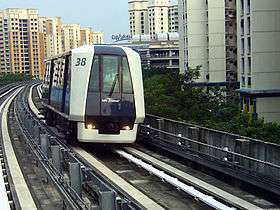
In several new towns, automated rubber-tyred light rail transit systems function as feeders to the main MRT network in lieu of feeder buses. The first LRT line, which is operated by SMRT Light Rail, opened in Bukit Panjang in 1999 to provide a connection to Choa Chu Kang in neighbouring Choa Chu Kang New Town. Although subsequently hit by over 50 incidents, some of which resulted in several days of system suspension, similar systems albeit from a different company were introduced in Sengkang and Punggol in 2003 and 2005 respectively, both operated by SBS Transit.
International rail links
The international railway line to Malaysia is an extension of the Malaysian rail network operated by Keretapi Tanah Melayu (Malayan Railways). Since 1 July 2011, Woodlands Train Checkpoint serves as the southern terminus of the KTM rail network. Previously, KTM trains terminated at Tanjong Pagar railway station in central Singapore. Two more rail links are being planned: the Kuala Lumpur-Singapore High Speed Rail terminating in Jurong East, and the Johor Bahru-Singapore Rapid Transit System between Woodlands North and Bukit Chagar, Johor Bahru.
Road transport
Buses
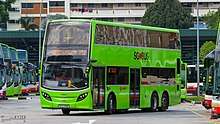
Bus transport forms a significant part of public transport in Singapore, with over 4.0 million rides taken per day on average as of 2019.[7] There are more than 365 scheduled bus services, operated by SBS Transit, SMRT Buses, Tower Transit Singapore and Go-Ahead Singapore. There are also around 5,800 buses, both single-deck and double-deck, currently in operation.
Since 2016, the Land Transport Authority regulates the public bus service standards and owns relevant assets whereas bus operators bid for operating bus services via competitive tendering.
Taxis and ridesharing services
_1.7_CRDi_sedan%2C_Comfort_Taxi_(2017-11-28).jpg)
Taxicabs are a popular form of public transport in the compact sovereign city-state of Singapore, with fares considered low compared to those in most cities in developed countries. Starting rates were $3.20 - $3.90. As of March 2019, the taxi population has been increased to 83,037. Taxis may be flagged down at any time of the day along any public road outside of the Central Business District (CBD). However, increased usage of ridesharing services like Grab and Gojek has resulted in a decrease in the usage of taxis.[7]
Private cars
As of 2018, there was a total of 957,006 motor vehicles in Singapore, with 509,302 of them being private cars.[8]
Roads and expressways
Singapore pioneered the modern use of toll roads to enter the most congested city centre area with the Singapore Area Licensing Scheme, which has since been replaced with the Electronic Road Pricing, a form of electronic toll collection.
- Total length of expressways: 164 km
- Total length of major arterial roads: 576 km
- Total length of collector roads: 704 km
- Total length of local access roads: 2056 km (as of 2017)[9]
Traffic drives on the left which is typical in Commonwealth countries.
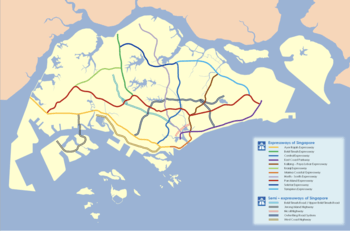
The planning, construction and maintenance of the road network is overseen by the Land Transport Authority (LTA), and this extends to expressways in Singapore. These form key transport arteries between the distinct towns and regional centres as laid out in Singapore's urban planning, with the main purpose of allowing vehicles to travel from satellite towns to the city centre and vice versa in the shortest possible distance. These expressways include:
- Ayer Rajah Expressway (AYE)
- Bukit Timah Expressway (BKE)
- Central Expressway (CTE)
- East Coast Parkway (ECP)
- Marina Coastal Expressway (MCE)
- Kallang–Paya Lebar Expressway (KPE)
- Kranji Expressway (KJE)
- Pan Island Expressway (PIE)
- Seletar Expressway (SLE)
- Tampines Expressway (TPE)
- North-South Expressway (under planning)
The influence of expressways on Singapore's transport policy developed shortly after independence during the history of Singapore because of frequent traffic congestion in the Central district. The aim was to encourage residential development in other parts of the island and give residents in these new "satellite towns" a convenient link between their homes and their workplaces (which were mostly situated around the city centre.)
Causeway and link bridge
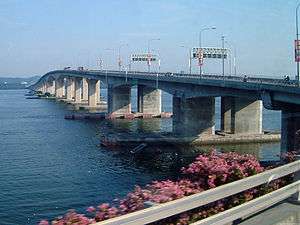
Singapore has two land links to Malaysia. The Johor-Singapore Causeway, built in the 1920s to connect Johor Bahru in Johor, Malaysia to Woodlands in Singapore, carries a road and a railway line. The Tuas Second Link, a bridge further west, was completed in 1996 and links Tuas in Singapore to Tanjung Kupang in Johor.
Trishaws
Before World War II, rickshaws were an important part of urban public transportation. Rickshaws were taken over by the trishaw after the world war as the former was banned in 1947 on humanitarian grounds.[10]
Usage of trishaws as a means of transportation had died out by 1983.[11] However, there are some trishaws left which now serve as tourist attractions, taking tourists for a ride around the downtown district.
Air transport
Airlines

.jpg)
There are six local scheduled service airlines, all of them operating from Singapore Changi Airport, offering scheduled flights to over 70 cities on six continents:
- Jetstar Asia Airways – founded 2004
- Scoot – founded 2011
- SilkAir – founded 1976
- Singapore Airlines – founded 1937 (as Malayan Airways)
- Tigerair – founded 2003 (merged with Scoot in 2017)
- Valuair – founded 2004 (merged with Jetstar Asia in 2005, brand retained for certain Jetstar Asia's services)
The national flag carrier, Singapore Airlines, operates from Changi Airport Terminal 2 and 3. Its subsidiaries, SilkAir and Scoot, operate from Changi Airport Terminal 2.
Singapore's budget airlines, Jetstar Asia Airways operates from Changi Airport Terminal 1.
Singapore Seletar Airport has also been reopened to the public, with Firefly services operating out of Seletar Airport.
Airports
The aviation industry is regulated by the Civil Aviation Authority of Singapore, a statutory board of the Singapore government under the Ministry of Transport.
An open skies agreement was concluded with the United Kingdom in October 2007 permitting unrestricted services from Singapore by UK carriers. Singapore carriers were allowed to operate domestic UK services as well as services beyond London Heathrow to a number of destinations, including the United States along with Canada.[12]
Singapore Changi Airport, with its four terminals, is one of the most important air hubs in the region. The international airport is situated at the easternmost tip of the main island, and serves 185 cities in 58 countries.[13] With the recent opening of the fourth terminal, Changi is now capable of handling more than 70 million passengers every year.
Seletar Airport is Singapore's first civil aviation airport and is primarily used for private aviation. The airport also serves regular commercial flights by Firefly to its Subang Airport hub. Limited scheduled commercial flights are also conducted by Berjaya Air to the Malaysian islands of Tioman Island and Redang Island.
| Airport | ICAO | IATA | Usage | Runway | Length (ft) | Length (m) | Remarks |
|---|---|---|---|---|---|---|---|
| Paya Lebar Air Base | WSAP | QPG | Military | Paved | 12400 | 3800 | Former civilian |
| Seletar Airport | WSSL | XSP | Civilian/Military | Paved | 6023 | 1836 | Mainly non-scheduled flights |
| Sembawang Air Base | WSAG | Military | Paved | 3000 | 914 | ||
| Singapore Changi Airport | WSSS | SIN | Civilian | Paved | 13200 | 4000 | |
| Tengah Air Base | WSAT | TGA | Military | Paved | 8900 | 2713 |
Heliports
Aerial lift transport
Cable car

The Singapore Cable Car is a three-station gondola lift system that plies between Mount Faber on the main island of Singapore and the resort island of Sentosa via HarbourFront. Opened in 1974, it was the first aerial ropeway system in the world to span a harbour. The cable car system underwent a revamp that was completed in August 2010.
In addition, a similar gondola lift system also operates within Sentosa as the Sentosa Line and was opened in 2015. This line links Siloso Point to Imbiah.[14]
Maritime transport
Ports and harbours

The Port of Singapore, run by the port operators PSA International (formerly the Port of Singapore Authority) and Jurong Port, is the world's busiest in terms of shipping tonnage handled. 1.04 billion gross tons were handled in 2004, crossing the one billion mark for the first time in Singapore's maritime history. Singapore also emerged as the top port in terms of cargo tonnage handled with 393 million tonnes of cargo in the same year, beating the Port of Rotterdam for the first time in the process. In 2019, it handled a total of 626 million tonnes of cargo.[15]
In 2018, Singapore was ranked second globally in terms of containerised traffic, with 36.6 million Twenty-Foot Equivalent Units (TEUs) handled,[16] and is also the world's busiest hub for transshipment traffic. Additionally, Singapore is the world's largest bunkering hub, with 49.8 million tonnes sold in 2018.[17]
In 2007, the Port of Singapore was ranked the world's busiest port, surpassing Hong Kong and Shanghai.[18] The Port of Singapore is also ranked the Best Seaport in Asia.
| Port | Operator | Type | Berths | Quay length (m) | Quay cranes | Area (m²) | Capacity (kTEUs) |
|---|---|---|---|---|---|---|---|
| Asia Automobile (Singapore) (AATS)[19] | K Line/Nippon Yusen/PSA International | Car | 2 | ||||
| Brani (BT)[20] | PSA International | Container | 8 | 2,325 | 26 | 790,000 | |
| Cosco-PSA (CPT) | Cosco/PSA International | Container | 5 | 720 | 228,000 | 5,000 | |
| Jurong | JTC | Multi-Purpose | 23 | 4,486 | 1,200,028 | ||
| Keppel (KT)[20] | PSA International | Container | 14 | 3,164 | 27 | 1,025,000 | |
| Magenta Singapore (MST)[19] | ONE/PSA International | Container | 4 | 4,000 | |||
| MSC-PSA Asia (MPAT)[19] | MSC/PSA International | 7 | 14 | ||||
| Pasir Panjang Automobile (PPT)[20] | PSA International | Ro-Ro | 3 | 1,010 | 250,000 | ||
| Pasir Panjang (PPT 1) | PSA International | Container | 6 | 2,145 | 19 | 850,000 | |
| Pasir Panjang (PPT 2) | PSA International | Container | 9 | 2,972 | 36 | 1,390,000 | |
| Pasir Panjang (PPT 3) | PSA International | Container | 8 | 2,655 | 31 | 940,000 | |
| Pasir Panjang (PPT 4) | PSA International | Container | 3 | 1,264 | 13 | 700,000 | |
| Pasir Panjang (PPT 5) | PSA International | Container | 6 | 2,160 | 24 | 830,000 | |
| Pasir Panjang (PPT 6) | PSA International | Container | 6 | 2,251 | 24 | 800,000 | |
| PIL-PSA Singapore (PPST)[19] | PIL/PSA International | Container | 3 | ||||
| Sembawang Wharves[20] | PSA International | General | 4 | 660 | 280,000 | ||
| Tanjong Pagar (TPT)[20] | PSA International | Container | 7 | 2,097 | 0 | 795,000 |
Passenger transport

Water transport within the main island is limited to the River Taxi along the Singapore River. The service was introduced in January 2013, with low ridership.[21][22] There are also daily scheduled ferry services from the Marina South Pier to the Southern Islands such as Kusu Island and Saint John's Island.[23]
Singapore Cruise Centre (SCC) runs Tanah Merah and HarbourFront Ferry Terminals which are connected by ferry services to Indonesian Riau Islands of Batam, Bintan and Karimun.[24]
References
- Singapore public transport system tops global list 23 August 2018. Retrieved 2016-01-31
- CNN Go 2 June 2014. Retrieved 2016-01-31
- Umar Zakir Abdul, Hamid; et al. (2019). "Current Landscape of the Automotive Field in the ASEAN Region: Case Study of Singapore, Malaysia and Indonesia - A Brief Overview" (PDF). ASEAN Journal of Automotive Technology. 1 (1). Retrieved 5 October 2019.
- "Two New Rail Lines and Three New Extensions to Expand Rail Network by 2030". www.lta.gov.sg. Retrieved 8 April 2019.
- "Jurong Region Line to serve NTU, Tengah estate, Jurong Industrial Estate". CNA. Retrieved 8 April 2019.
- "First phase of Cross Island MRT line finalised; will have 12 stations". The Straits Times. 25 January 2019. Retrieved 8 April 2019.
- "Bus, train ridership rises to new high". The Straits Times. 13 February 2020. Retrieved 13 February 2020.
- "Annual Vehicle Statistics 2018: MOTOR VEHICLE POPULATION BY VEHICLE TYPE" (PDF). Land Transport Authority. Archived from the original (PDF) on 19 January 2017. Retrieved 7 March 2020.
- "Length of Roads Maintained by LTA". Land Transport Authority. 6 April 2018. Retrieved 7 March 2020.
- "Infopedia: Rickshaw". Retrieved 27 October 2019.
- Lim, Jason (2012). A Slow Ride into the Past: The Chinese Trishaw Industry in Singapore, 1942-1983. Monash University Publishing. ISBN 978-1921867385.
- "Singapore, UK conclude landmark Open Skies Agreement". Channelnewsasia.com. 3 October 2007.
- "Air Network". changiairport.com. Archived from the original on 25 March 2008. Retrieved 26 March 2008.
- "New cable car service to help visitors get around Sentosa". The Straits Times. 14 July 2015. Archived from the original on 7 July 2019. Retrieved 7 July 2019.
- "Cargo Throughput, Monthly". Data.gov.sg. 28 January 2020. Retrieved 7 March 2020.
- "Top 50 World Container Ports". World Shipping Council. Retrieved 7 March 2020.
- "Singapore's 2018 Maritime Performance". Maritime and Port Authority of Singapore. 14 January 2019. Archived from the original on 29 September 2019. Retrieved 7 March 2020.
- "Singapore remains world's busiest port". Xinhuanet. 12 January 2006.
- "Our Business: Joint-Venture Terminals". www.singaporepsa.com. Retrieved 7 March 2020.
- "Our Business: Terminals". www.singaporepsa.com. Archived from the original on 14 January 2020. Retrieved 7 March 2020.
- "Water taxis to make a splash in Singapore". Telegraph. 27 December 2011. Retrieved 6 April 2014.
- "Few using water taxis as regular mode of commute". TODAY. 2 August 2013. Retrieved 6 April 2014.
- "Singapore Island Cruise". islandcruise. Retrieved 6 April 2014.
- "wowgetaways.com". SCC. Archived from the original on 13 March 2018. Retrieved 13 March 2018.
Further reading
Teo, Eisen (2019). Jalan Singapura : 700 Years of Movement in Singapore. Singapore: Marshall Cavendish. ISBN 9789814828741.
External links
| Wikimedia Commons has media related to Transport in Singapore. |
- Ministry of Transport
- Public Transport Council
- Land Transport Authority
- TransitLink
- PublicTransport@SG at the Library of Congress Web Archives (archived 2012-04-18)
- Taxi Singapore and Transport Guide
